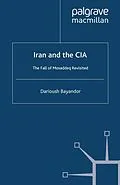In the early 1950s, frail septuagenarian prime minister of Iran, Doctor Mohammad Mosaddeq, shook the world - challenging Britain by nationalizing Iran's British-run oil industries. In August 1953 he was overthrown. Revisiting these events with astonishing new evidence, this book challenges the conventionally-held theory of foul play by the CIA.
Autorentext
DARIOUSH BAYANDOR is currently an Iran analyst and historian living in Switzerland. Born Iranian, the author held diplomatic posts in New York and Tehran and was a lecturer on international law, diplomacy and international institutions in Tehran University, the National University of Tehran as well as in the diplomatic school of the foreign ministry prior to the Islamic Revolution. He joined the United Nations in 1980 where he notably headed several UN humanitarian offices in different continents, stretching over a twenty-year period.
Inhalt
Introduction How the story evolved How did a myth about the CIA role develop and prevail? Why did the CIA files remain unclassified? 1 THE CONTEXT Foreign influence as a prime mover in Iranian politics The Tudeh Party The Azerbaijan Crisis, 194546 Shah Mohammad-Reza Pahlavi The Ulama as a socio-political force Ayatollah Seyyed Abol'qassem Kashani: the precursor of clerical activism Razmara: prelude to the oil nationalization crisis 2 THE ADVENT OF MOSADDEQ AND THE OIL CRISIS The rise of the National Front The nomination of Mosaddeq Doctor Mohammad Mosaddeq: a sketch The initial British reaction to oil nationalization The early American attitude to the oil dispute Political line-ups in Tehran Early conduct of the oil dispute The British complaint to the Security Council The Washington oil talks The World Bank proposal Early forebodings 3 MOSADDEQ'S SECOND GOVERNMENT, JULY 1952 TO AUGUST 1953 The Qavam hiatus and the Siy'e Tyr popular uprising (21 July 1952) Rift among Mosaddeq supporters A wedge to break the oil log-jam: the Truman-Churchill joint offer Mosaddeq's reforms and the theory of legitimacy The British two-pronged strategy: subversion and engagement The covert track The engagement track Diplomatic relations with Britain are broken off Final attempts to resolve the oil dispute A day forgotten in the Iranian collective memory 4 THE DOWNSLIDE The clash at the helm; the February 1953 jumble The Grand Ayatollah Boroujerdi: a retrospective sketch General Fazlollah Zahedi Internal conspiracies The abduction of the police chief The link-up: TPAJAX and the internal cabal The summer of all dangers The taming of the Shah The failure of the TPAJAX coup 5 THE DOWNFALL The gathering storm, 1618 August 1953 The backlash: events leading to the fall of Mosaddeq on 19 August Monitoring by the US Embassy The final hours The military factor in the fall of Mosaddeq TPAJAX military planning and the role of Iranian officers 6 THE ANATOMY OF 19 AUGUST CIA station activism inTehran, 1619 August The role of Iranian agents Surprise in Washington Ambassador Henderson's last meeting with Mosaddeq The CIA money An orphan British secret document Analysis of the British secret document A coup d'état, a popular uprising or something else? 7 WHERE DID THE SPARK COME FROM? The missing link: the Boroujerdi factor 8 SUMMARY AND CONCLUSIONS Power structure and internal dynamics in the early 1950s Mosaddeq's rule The handling of the oil crisis and stalemate External and internal conspiracies The TPAJAX coup and its aftermath The involvement of ulama The causes of Mosaddeq's defeat Notes Direct Sources of the Study Index
Titel
Iran and the CIA
Untertitel
The Fall of Mosaddeq Revisited
Autor
EAN
9780230277304
ISBN
978-0-230-27730-4
Format
E-Book (pdf)
Hersteller
Herausgeber
Veröffentlichung
03.03.2010
Digitaler Kopierschutz
Wasserzeichen
Dateigrösse
2.38 MB
Anzahl Seiten
247
Jahr
2010
Untertitel
Englisch
Unerwartete Verzögerung
Ups, ein Fehler ist aufgetreten. Bitte versuchen Sie es später noch einmal.
